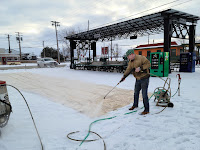Frank writes...
I showed up at the museum on Sunday and my first job was to install the new brake linkage parts on the 18. I got this job mostly done, but forcing one of the radius bars over to get everything to drop into place was beyond my meager horsepower so I'll need to come back to that. But when I headed back over to the shop, the usual Sunday crew had assembled and presented me with a new and more interesting plan.
And here's Richard taking a turn. For the most part Richard, Nick, and I traded off running the pressure washer while Greg ran a garden hose off of a separate spigot at the far end of the canvas to get a jump on wetting down that end.
The goal was to really soak the canvas and drive out the sizing. What's sizing, you ask? It's a (usually acrylic) material that the canvas is coated with to prevent paint and other liquids from penetrating the canvas fibers. It's that oily-looking brown stuff visible above. It's not actually an oil; it's being prevented from soaking in by the sizing in the canvas itself. While this is undoubtedly useful if you're painting someone's portrait and you want your paint to sit on the surface of your canvas instead of being absorbed into it, it's not what we want for car roofs - we want the canvas to absorb the paint we put on it. We also don't want the canvas to try and shrink or loosen after it's been tacked to the car roof.
It took a while to soak the canvas. Above, Greg (left) and Nick are hard at work. We started hosing down the canvas at about 3:30 in the afternoon and got to the end of the 12'x60' piece about an hour later... at which point it was time to flip it over and do the other side, of course! The canvas is thick enough that even with the pressure washer, most of the canvas hadn't been soaked all the way through. No wonder it works well for car roofs. The reverse side went quicker, though.
Here's Nick getting close to finishing up the second side right around sunset, which was shortly before 5:00. After we got this done, we dragooned innocent bystanders Thomas, Ashton, Jeron, and Nick D into helping to haul the saturated canvas over to Barn 7, where it was set up on sawhorses to drip dry. This may take a couple of days, depending on the temperature, but once the canvas is no longer actively dripping water it can be brought into either Barn 4 or even into the heated shop to finish air drying before installation. THANK YOU to everyone who helped with this project, especially the three guys who spent the afternoon watering down the canvas in sub-freezing temperatures!
So what else was happening? I didn't get any photos of the brake installation on the 18 but it's tough to get pictures under the car anyway. As mentioned before, Thomas and Ashton were out and they were working on interior panels for the Baldy, which is getting a full down-to-the-metal strip and repaint. It will really be a showpiece when they're done. There was also progress on Sand Springs 68. Above is a new brake lever that I believe had been cut out and ground to shape on Saturday; this will replace a badly worn original. And Jack finished up his project of removing, lapping, and reinstalling the 68's two whistle valves to repair their air leaks. The exciting news about that is that he is going to look at repairing the 18's whistle valve next. The whistle valve is the source of one of the largest remaining air leaks on the car since some air work last August so that will be a huge help.
Tim was working on a door for 50th Avenue earlier in the day. Jeron was in the shop, though I'm not positive what he was working on, and Nick D from the Coach Department was working elsewhere on the property but stopped in a couple of times. Nobody from the Michigan Electric project was out but I snapped the above photo showing progress on the window sill and posts on the south (left) side of the car just aft of the baggage doors.








3 comments:
I would really like to thank everyone who helped with the 453 canvas -- it's something I couldn't do by myself and will greatly speed up the whole project. You guys are the best!
I'm surprised you would wash the sizing out of the canvas. When I produced oil cloth items for historical interpretation, I had to make my own sizing with corn starch. I then used a mixture of linseed oil, turpentine, lamp black for pigment and Japan drier which was a substitute for litharge which is made from oxidized lead. This mixture was basically enamel paint without the additives that is used in todays paints. It made for a waterproof material. When the paint (which will have enough tooth to adhere with the sized cloth) is painted onto the sized canvas, it made for a far superior waterproof material than just my homemade mixture and rustoleum
applied to plain canvas.
If you've have had issues with the sizing making the paint flake off, I had issues with using rustoleum on sized fabric in a way to cheat, but then realized that artists use linseed oil based paints and I believe most modern enamel paints use petroleum based oils.
We use a special canvas paint which is mixed for us, and not commercially available. It's linseed oil-based, certainly, and not Rustoleum. The canvas soaks up an amazing amount of this paint, but the result is durable and yet flexible enough for our application. I don't know enough about paint chemistry to tell you more than that. Can somebody get Pete on the line?
Post a Comment